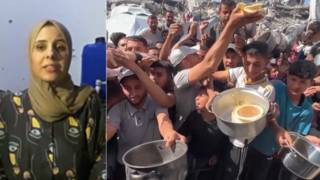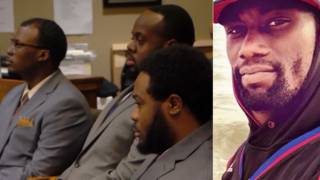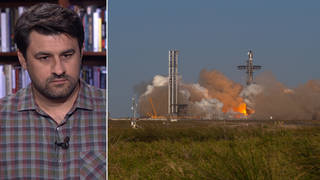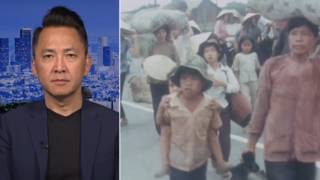
Guests
- Jerry RedfernSenior Fellow at the Schuster Institute for Investigative Journalism at Brandeis University and co-author of the book Eternal Harvest: The Legacy of American Bombs in Laos.
- Karen CoatesCo-author of the book Eternal Harvest: The Legacy of American Bombs in Laos and a Senior Fellow at the Schuster Institute for Investigative Journalism at Brandeis University.
Fifty years ago this month, the United States began raining down bombs on Laos, in what would become the largest bombing campaign in history. From June 1964 to March 1973, the United States dropped at least two million tons of bombs on the small, landlocked Southeast Asian country. That is the equivalent of one planeload every eight minutes, 24 hours a day, for nine years — more than was dropped on Germany and Japan during World War II. The deadly legacy of the Vietnam War lives on today in the form of unexploded cluster bombs, which had about a 30 percent failure rate when they fell from American planes over large swaths of Laos. Experts estimate that Laos is littered with as many as 80 million “bombies,” or bomblets — baseball-sized bombs found inside cluster bombs. Since the bombing stopped four decades ago, tens of thousands of people have been injured or killed as a result. We are joined by Karen Coates and Jerry Redfern, co-authors of “Eternal Harvest: The Legacy of American Bombs in Laos.”
Transcript
NERMEEN SHAIKH: Fifty years ago this month, the U.S. began raining down bombs on Laos in what would become the largest bombing campaign in history. From June 1964 to March 1973, the U.S dropped at least two million tons of bombs on the small, landlocked Southeast Asian country. That’s the equivalent of one planeload every eight minutes, 24 hours a day, for nine years—more than were dropped on Germany and Japan during World War II.
The deadly legacy of the Vietnam War lives on today in the form of unexploded cluster bombs, which had about a 30 percent failure rate when they were dropped from American planes over large swaths of Laos. Experts estimate that Laos is littered with as many as 80 million “bombies,” or bomblets—baseball-sized bombs found inside cluster bombs. Well, since the bombing stopped four decades ago, tens of thousands of people have been injured or killed as a result.
Last year, Democracy Now! spoke to Thoummy Silamphan, a bomb accident survivor and victim assistance advocate. He explained how a bomb exploded when he was an eight-year-old child collecting bamboo shoots.
THOUMMY SILAMPHAN: One day, I needed to find some bamboo shoots for to feed my family, to make soup. So—and when I saw the bamboo shoots, and I tried to dig into bamboo shoots. After that, the bombie explode to me.
AMY GOODMAN: What you call a “bombie,” like a bomblet, exploded?
THOUMMY SILAMPHAN: Yes, because at that time in my village or in those areas, we have a lot of the bombing, and we don’t know the bomb under ground. And when we’re digging for bamboo shoots, and then the UXO explode to me, yeah. And it get—I lost my left hand. And that time, it’s very, very difficult for me to continue my life.
AMY GOODMAN: For more on Laos, we go now to New Mexico public television in Albuquerque to speak with Karen Coates and Jerry Redfern, the co-authors of a remarkable new book called Eternal Harvest: The Legacy of American Bombs in Laos. They spent more than seven years in Laos working on the book.
Karen and Jerry, welcome to Democracy Now! Karen, let’s begin with you. Why did you write this book? And talk about the significance of this month, the 50th anniversary of the largest, most significant—well, the largest bombing in history.
KAREN COATES: Well, we were in the country in 2005 to work on an article for Archaeology Magazine, and at that point we had been living in the region for several years. We had visited Laos before. We knew the history, as Americans. But we had no idea the extent of the problem until we were there that trip. And in about two weeks during that time, we had heard of more than 20 accidents around the region where we were. And we sort of looked at each other and said, this is much bigger, a much bigger problem than we realized.
And one day we went to a local hospital and encountered a 10-year-old boy who had been in his farm field digging when he hit something, most likely a bombie, which blew up in his face. And we saw him. We interviewed his mother, and she said, “We know the problem, but what can my family do? Because we have to farm. We have to dig. We have to go to the field. And we know it’s dangerous, but we’re risking our lives every time we do.” And so, that’s when Jerry and I said to each other, “We need to do something much bigger than an article. We need—we need to investigate this.”
NERMEEN SHAIKH: And how did you—Jerry, perhaps you could answer this—how did you go about conducting your research? How many people, survivors, did you speak with for your book?
JERRY REDFERN: The reporting that we did was essentially grassroots reporting. We did it by traveling throughout the country from north to south and east to west, just going from village to village and asking people, “Do you have a bomb problem? Have you had problems with bomb accidents?” I can’t begin to guess how many people we talked to. Hundreds upon hundreds, from way up near the Chinese border in the north to down close to the Cambodian border in the south, all along the Vietnamese border on the east, and along the Thai border in the west, as well.
Sort of the way that we began or followed up on the reporting is, the United States actually kept track of most of the bombing raids that were conducted. And in around 2000, the Clinton administration gave this bombing data to the Lao government, the Cambodian government and Vietnamese government, since we bombed those countries, as well, to help them clear up this UXO after the fact. And the Lao government, with help from other aid groups, put together a series of maps showing the places in the country that had been most heavily bombed. And we essentially took those bombing maps and went to the areas of highest concentration and just asked people what sort of problems they had.
AMY GOODMAN: Karen Coates, go back 50 years ago. I mean, there are many people who are watching or listening to this broadcast right now who have no idea what happened. Why did this bombing campaign begin? Tell us the history of the U.S. bombing of Laos.
KAREN COATES: It’s a complicated question, but, really, it was a two-pronged air war. One of the primary goals was to basically wipe out the transmission of people and supplies through the Ho Chi Minh Trail between North Vietnam and South Vietnam, which went through Laos. And then, the other part was to aid our allies in the north against a communist insurgency. But it was much larger than that. In the end, every province was hit, to some extent.
AMY GOODMAN: This is during the presidency of President—and what was the rationale of President Nixon? And talk about the secrecy around it all.
JERRY REDFERN: Well, it actually began with LBJ in 1964, before Nixon came into office. And from reading the Air Force history of the overall campaign, it looks like LBJ actually began it thinking it would just be a couple of small bombing operations in the north of the country, maybe a little bit in the east. But by the end of 1964, what we kind of think about as the bombing that happened in the Vietnam War, the sort of huge, large-scale carpet bombing, that began by December. Nixon vastly increased the amount of bombing that went on in Laos, but it really did begin under LBJ.
AMY GOODMAN: Let’s turn to the video you produced to accompany your book. This is Jim Harris, the founder of We Help War Victims. He spoke about the bombing campaign against Laos.
JIM HARRIS: The bombing campaign was to interdict the southbound traffic of North Vietnamese soldiers heading into South Vietnam. And that traffic went down what we called the Ho Chi Minh Trail. We also bombed in support of the Hmong troops who were our allies in the war up in Xiangkhouang province. But a map of Lao indicating the full range of the bombing is really staggering for how—how much of the country was hit.
AMY GOODMAN: Karen Coates, take it from there.
KAREN COATES: Well, when you see that map, it’s almost unbelievable—it still is for me when I look at it today—because you can see how the entire country, almost, was covered, layer upon layer upon layer of bombs. And those bombs still come up from the ground today.
NERMEEN SHAIKH: And so, Jerry, can you talk about what the effects are on people today? Your story tells—your book tells the story of a woman named Ta. You tell a number of stories; one of them is of a woman named Ta and her dead son Bunyon. Can you talk about that story and how representative it is of the hundreds of people you spoke to who are still suffering the effect of this bombing campaign?
JERRY REDFERN: That was a particularly astonishingly sad story. It’s a very—excuse me—that happened in a particularly poor part of the country, again, close to the Vietnamese border, at an entry point for the Ho Chi Minh Trail coming into Laos. So it was extremely heavily bombed. And the people there are very poor farmers. And essentially, the second crop during the year that they have is to go out and collect bomb scrap, either intact bombs or shrapnel from exploded bombs. And then they trade this for money, essentially, and that scrap metal goes into various other products, you know, for like rebar or spoons or things like that. But her son, as far as we could tell from people who survived, he and a couple other people had found some sort of bomb they didn’t recognize and were digging it up, when it exploded and essentially wiped him and at least two other people out completely. And everybody in this village knew the dangers of this sort of thing. People from this village had been killed regularly for years, but they still went out to try to collect it because they were so heavily impoverished. It was just—it was really a terrible story.
AMY GOODMAN: I want—
JERRY REDFERN: But unfortunately not the only story like that.
AMY GOODMAN: I want to go back to Thoummy Silamphan, the bomb accident survivor and victim assistance advocate in Laos, who was in our studios. He spoke about the legacy of the U.S. bombing campaign against his country.
THOUMMY SILAMPHAN: As the war is ended and stopped many years ago, but now the UXO continue to kill and injure people, until now. And that is why we want to involve for the Legacies of War. I think Legacies of War is very, very important for the Lao people, especially for the UXO clearance and for victim assistance in Laos, because now we have more than hundred town the UXO explode in Laos. And now we also have many survivors that are just waiting for support and help.
AMY GOODMAN: That’s Thoummy Silamphan, the bomb accident survivor and victim assistance advocate in Laos. Karen, can you explain UXO, the unexploded ordnance, that remain littering the country, and particularly what people in Laos feel is the responsibility of the United States today, 50 years later? And, Jerry, weigh in, as well.
KAREN COATES: So, the unexploded ordnance remaining—and that’s a term that covers all types of munitions that are left over, but the most common variety are the cluster bombs, or little bombies that you referred to earlier, which—they were packed into canisters that opened in midair and scattered all across the land. And those are particularly dangerous because they’re small. They’re about the size of a baseball. They can look like rocks to farmers. They can look like toys to kids. And if a person encounters one, it’s nearly impossible to tell whether that thing is going to blow or not. And often, it will blow up if a person moves it or throws it or something like that.
JERRY REDFERN: They’re also a particularly pernicious weapon, because they’re not designed to injure or just—you know, like a landmine, when used by the military, is meant to take one person out, and then maybe two other people have to take that person out of battle. These are—these tiny, little baseball-sized explosives are meant to kill anything within about 30 yards or so. And then you have hundreds of them in an area. It’s actually kind of remarkable to find people who survive accidents with these things, because they are intended to murder people.
KAREN COATES: But they aren’t the only bombs that are remaining.
AMY GOODMAN: And the U.S. responsibility—
KAREN COATES: For example—
AMY GOODMAN: —today? We just have 30 seconds.
JERRY REDFERN: That’s a good question. What we’ve been thinking is that the United States needs to come up with plans for what to do after we go into war. United States likes to plan wars a bit, but the after-effects, the aftermath, planning what to do with all the stuff that’s left behind, seems to be not considered much.
AMY GOODMAN: Well, Jerry Redfern and Karen Coates, we want to thank you for being with us, co-authors of Eternal Harvest: The Legacy of American Bombs in Laos. And thanks so much to New Mexico PBS.
That does it for our show. We have two job openings. Democracy Now! is hiring an administrative director and a Linux systems administrator, as well as fall internships. Visit democracynow.org/jobs for more information.












Media Options